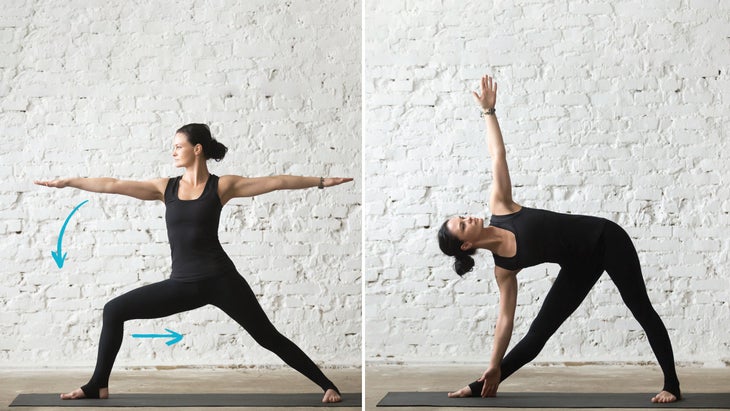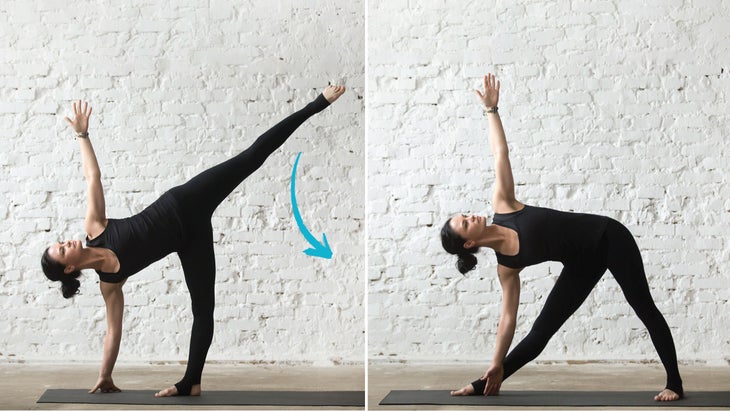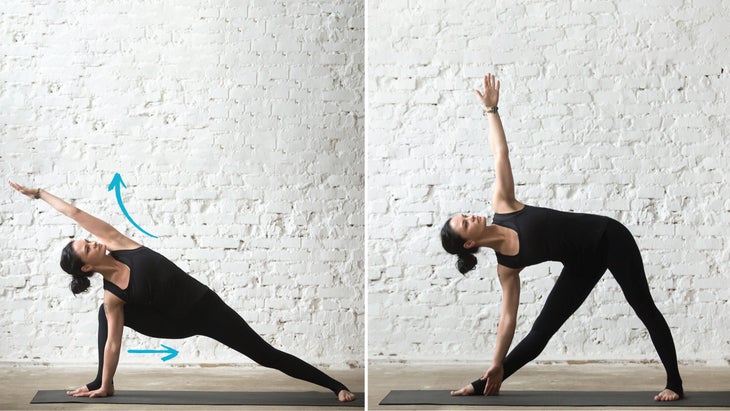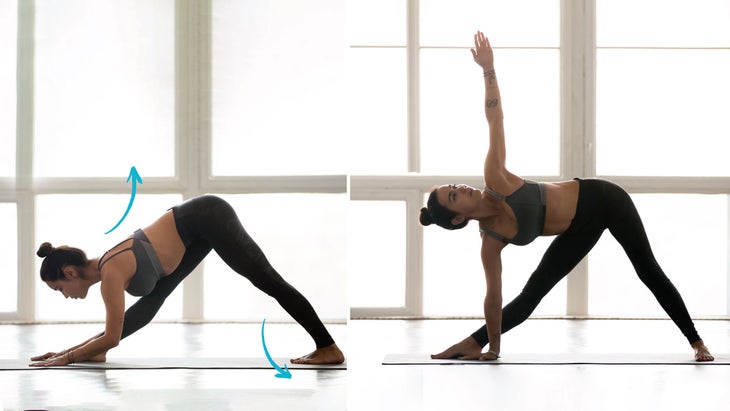6 Strategies to Transition Into Triangle Pose
“], “filter”: { “nextExceptions”: “img, blockquote, div”, “nextContainsExceptions”: “img, blockquote, a.btn, a.o-button”} }”>
Heading out the door? Be taught this textual content on the model new Open air+ app on the market now on iOS models for members!
>”,”establish”:”in-content-cta”,”type”:”hyperlink”}}”>Get hold of the app.
My widespread yoga observe is solely that: widespread. I am going to thankfully do the equivalent exact poses within the equivalent exact order every morning for months, altering points solely ever so barely over time. This enables me to alter into acutely aware of the refined shifts in my observe—and myself—that occur in consequence.
Nevertheless as loads as I respect routine, I typically crave novelty. That usually means tackling a troublesome yoga pose. Additional usually, though—and perhaps not surprisingly—I uncover myself reapproaching a pose I’ve accomplished so many cases over time that it’s deeply ingrained in my ideas and physique. Not too long ago, it’s been Trikonasana or Triangle Pose.
A technique I try and experience a pose from a model new perspective is to really change how I come into it, whether or not or not I’m coaching at home or sequencing it at college for school children. Altering my technique to Triangle Pose is usually adequate to recreate the pose as if we’ve got been experiencing it the first time. Each transition into Triangle emphasizes utterly totally different options of it—whether or not or not the leg positioning or the shoulders or the side physique.
Shifting into the equivalent pose in a model new strategy may additionally provide help to break freed out of your bodily and psychological patterns—that robust discernment between routine and rut—which in flip encourages us to be further acutely aware whereas we’re inside the pose. Even a pose we might assume everyone knows pretty intimately.

Warrior II to Triangle Pose
Why the transition works: Coming into Trikonasana (Triangle Pose) from Virabhadrasana II (Warrior II Pose) is a fairly customary transition in vinyasa programs. However it’s nonetheless worth exploring. Usually after we do one factor out of habits, we fall into sloppy conduct and overlook the small print of how we’re holding ourselves in each second.
First, your base. In Virabhadrasana II, your ft are roughly the equivalent distance apart as in Trikonasana, which makes it a simple transition. Nevertheless be blissful to play with the place of your ft to go well with what’s occurring in your knees and hips. Within the occasion you experience discomfort in your once more knee or hip, change the angle of your once more foot. Turning it in further minimizes strain on that knee and hip. You may additionally shorten the hole between your ft to create a steadier foundation (study: a lot much less hazard of toppling over).
Subsequent, coming into into Trikonasana. This transition is usually taught with a “hip bump,” by which you jut your once more hip further away from you and slide your entrance hand and arm forward. For some of us, though, this creates an extreme quantity of stress on the sacroiliac (SI) joint. An alternate method to return into Trikonasana is the “side hinge”—merely hinge at your entrance hip to let your entrance hand land wherever it wants, whether or not or not in your foot, shin, or a block.
: From Virabhadrasana II, inhale and straighten your entrance leg. Regulate your once more foot now to be somewhat bit nearer to the doorway leg, if wished. Exhale, and side-hinge at your entrance hip and let your entrance hand fall to your foot, shin, or a block positioned immediately beneath your shoulder. Attain your prime arm away from you to stack your shoulders. Flip your face in direction of your prime hand.

Reverse Warrior Pose to Triangle Pose
Why the transition works: Transitioning to Trikonasana from Viparita Virabhadrasana (Reverse Warrior Pose) is very similar to making the transition from Warrior II. Nevertheless the “windmilling” of the arms makes this transition further fluid, as you’d experience all through vinyasa, and brings further of a element of ease and elegance than you experience in numerous transitions.
The vital factor to doing this transition is timing. Your arms start shifting first, although it’s worthwhile to start to straighten your entrance leg—with out locking or hyperextending the knee—as you get to the hip hinge and sooner than you progress completely into Trikonasana. Contemplate it as a dance between your larger and reduce physique.
: From Viparita Virabhadrasana, straighten your entrance leg as you start to windmill your prime hand to your foot, shin, or a block positioned immediately beneath your shoulder. Delay your totally different hand to the sky and change your chest in direction of the prolonged side of the mat and your face in direction of your prime hand.

Half Moon Pose to Triangle Pose
Why the transition works: Usually vinyasa lecturers downside school college students to transition from Trikonasana to Ardha Chandrasana (Half Moon Pose). The opposite transition can be merely as troublesome—and doable.
Focus first on bringing your once more leg to the mat as softly as doable; you will almost definitely should bend your entrance knee barely to make this happen. As quickly as you probably can land with relative ease and quiet (moderately than stomping your once more foot down), work on touching down in a kind as close to Trikonasa as doable, slowly straightening your entrance leg, extending forward over your entrance leg, and bringing your hand to your foot, shin, or a block.
: From Half Moon Pose, gaze down on the foot of your standing leg. As you exhale, bend this knee barely and start to lower your once more foot in direction of the mat. As quickly as your once more foot has touched down, modify its place to be angled barely out and straighten your entrance leg. Carry your entrance hand to your foot, shin, or a block positioned immediately beneath your shoulder. Regulate the place of your prime hand, chest, and prime hip—which are already close to the place they should be. Within the occasion you experience wobbliness, you probably can carry your prime hand to your once more hip as you begin to transition after which, after your ft are in place, attain your prime arm in direction of the ceiling.

Warrior I to Triangle Pose
Why the transition works: Starting from a Virabhadrasana I (Warrior I) lets you give consideration to the spine movement and chest opening that is typical of Trikonasana. This facet is usually uncared for in Triangle since there is a tendency to slouch inside the chest house to get the underside hand close to the mat—a mistake as a result of the extent of the pose is to hunt out development and dimension all by the physique. It’s about how the pose feels, not the best way it seems.
Warrior I begins with the once more heel down and the foot angled forward. You’ll should transition by the use of a mannequin of Warrior I by which there is a forward bend at your hips alongside along with your stomach resting in your thigh. Then you definately definately’ll carry your palms to each side of your entrance foot sooner than twisting
: From Virabhadrasana I, exhale as you fold forward at your hips and produce your stomach to your entrance thigh and your palms to each side of your entrance foot. Place the same-side hand on the best of your entrance foot. Place your once more foot for Trikonasana; this might suggest angling it further in direction of the side of the mat. Inhale as you attain your prime hand and arm in direction of the ceiling and open your chest in direction of the prolonged side of the mat, holding your entrance knee bent. Exhale proper right here. Inhale and straighten your entrance leg as you lengthen by the use of your bottom ribs. You might wish to slip your hand up your shin to return completely into Trikonasana.

Extended Side Angle to Triangle
Why the transition works: Shifting into Trikonasana from Utthita Parsvakonasana (Extended Side Angle) is a simple transition that helps you give consideration to extending and lengthening your side physique on account of it occurs in every poses. This transition can be accomplished whether or not or not you have acquired your hand on the bottom in Side Angle, a block, or your forearm in your thigh. Preserve your core engaged all by to help assist your torso as you straighten your leg.
: You most likely have your hand or fingertips on the bottom in Extended Side Angle, keep your hand in place as you start to straighten your entrance leg and change your once more toes barely out. You might wish to regulate the place of your once more foot to be nearer to your entrance foot. As quickly as your entrance leg is straight, attain your prime arm in direction of the sky and lookup.
You most likely have your forearm in your thigh in Extended Side Angle, switch your hand to the place you usually place it in Trikonasana, whether or not or not a block or your shin, sooner than completely straightening your entrance leg. You might wish to regulate the place of your once more foot to be nearer to your entrance foot. As quickly as your entrance leg is straight, attain your prime arm in direction of the sky and lookup.

Pyramid Pose to Triangle Pose
Why the transition works: Starting from Parsvottanasana (Pyramid Pose or Intense Side Stretch Pose) lets you assemble Trikonasana from the underside up. As with Trikonasana, your entrance leg in Parsvottanasana is straight. Nonetheless, your once more foot could be angled further forward in Pyramid than in Trikonasa on account of it’s a front-facing forward fold,. So modify the place of your once more foot to face out further, in direction of the prolonged side of the mat. You may additionally modify the dimensions of your stance, if wished, sooner than completely opening up into Trikonasa.
: From Pyramid Pose, carry your hand on the equivalent side as your entrance leg to your foot, shin, or a block positioned immediately beneath your shoulder; rest the other hand subsequent to it. Shift your weight to the doorway foot and slide or step your once more foot into an excellent place for Trikonasana. Lengthen your spine and flatten your larger once more, which might require sliding your hand further up your leg.
See moreover: Angle of Repose: Trikonasana
About our contributor
Shawn Radcliffe is a yoga teacher and writer who explores the world by the use of phrases and movement. His personal observe and educating are influenced by the Viniyoga vogue of T.Okay.V. Desikachar, and he continues to overview with lecturers on this lineage. He moreover attracts on the power yoga and vinyasa motion of his early yoga years in Philadelphia, Pennsylvania, and Portland, Oregon., along with Buddhist-based meditation practices. In school, he studied every science and writing, which finally led him to his current job as a science journalist. Shawn lives near the Bruce Peninsula in Ontario, Canada, the place he teaches on-line and in-person yoga programs.






